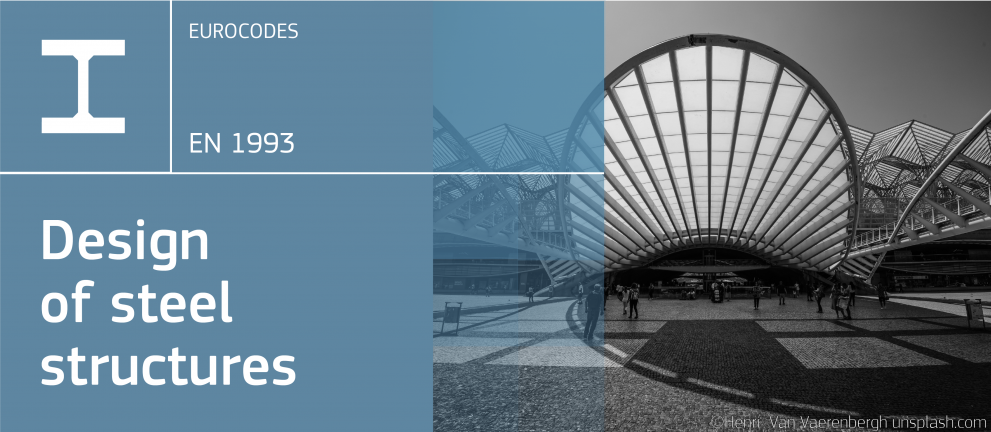

EN 1993 Eurocode 3 applies to the design of buildings and other civil engineering works in steel. It complies with the principles and requirements for the safety and serviceability of structures, the basis of their design and verification that are given in EN 1990 – Basis of structural design. EN Eurocode 3 is concerned with requirements for resistance, serviceability, durability and fire resistance of steel structures.
EN Eurocode 3 is wider in scope than most of the other design EN Eurocodes due to the diversity of steel structures, the need to cover both bolted and welded joints and the possible slenderness of construction. EN 1993 has about 20 parts covering common rules, fire design, bridges, buildings, tanks, silos, pipelines, piling, crane supported structures, towers and masts, chimneys, etc.
EN Eurocode 3 is intended to be used in conjunction with:
- EN 1990: Eurocode - Basis of structural design;
- EN 1991: Eurocode 1 - Actions on structures;
- ENs, ETAGs and ETAs for construction products relevant for steel structures;
- EN 1090: Execution of steel structures - Technical requirements;
- EN 1992 to EN 1999 when steel structures or steel components are referred to.
Parts
| EN 1993-1-1:2005 | Eurocode 3: Design of steel structures - Part 1-1: General rules and rules for buildings |
| EN 1993-1-2:2005 | Eurocode 3: Design of steel structures - Part 1-2: General rules - Structural fire design |
| EN 1993-1-3:2006 | Eurocode 3: Design of steel structures - Part 1-3: General rules - Supplementary rules for cold-formed members and sheeting |
| EN 1993-1-4:2006 | Eurocode 3: Design of steel structures - Part 1-4: General rules - Supplementary rules for stainless steels |
| EN 1993-1-5:2006 | Eurocode 3: Design of steel structures - Part 1-5: General rules - Plated structural elements |
| EN 1993-1-6:2007 | Eurocode 3: Design of steel structures - Part 1-6: Strength and stability of shell structures |
| EN 1993-1-7:2007 | Eurocode 3: Design of steel structures - Part 1-7: Strength and stability of planar plated structures subject to out of plane loading |
| EN 1993-1-8:2005 | Eurocode 3: Design of steel structures - Part 1-8: Design of joints |
| EN 1993-1-9:2005 | Eurocode 3: Design of steel structures - Part 1-9: Fatigue |
| EN 1993-1-10:2005 | Eurocode 3: Design of steel structures - Part 1-10: Material toughness and through-thickness properties |
| EN 1993-1-11:2006 | Eurocode 3: Design of steel structures - Part 1-11: Design of structures with tension components |
| EN 1993-1-12:2007 | Eurocode 3: Design of steel structures - Part 1-12: General - High strength steels |
| EN 1993-2:2006 | Eurocode 3: Design of steel structures - Part 2: Steel bridges |
| EN 1993-3-1:2006 | Eurocode 3: Design of steel structures - Part 3-1: Towers, masts and chimneys – Towers and masts |
| EN 1993-3-2:2006 | Eurocode 3: Design of steel structures - Part 3-2: Towers, masts and chimneys – Chimneys |
| EN 1993-4-1:2007 | Eurocode 3: Design of steel structures - Part 4-1: Silos |
| EN 1993-4-2:2007 | Eurocode 3: Design of steel structures - Part 4-2: Tanks |
| EN 1993-4-3:2007 | Eurocode 3: Design of steel structures - Part 4-3: Pipelines |
| EN 1993-5:2007 | Eurocode 3: Design of steel structures - Part 5: Piling |
| EN 1993-6:2007 | Eurocode 3: Design of steel structures - Part 6: Crane supporting structures |
News
Events
Decoding Eurocode 3+7
- United Kingdom
Decoding Eurocode 3+7
- United Kingdom
Eurocodes Masterclasses
- United Kingdom
Publications
Designers' Guide to EN 1993-2 Eurocode 3: Design of steel structures part 2, steel bridges
This Designers' Guide provides the user with guidance on the interpretation and use of EN 1993-2 and also the relevant provisions in EN 1993-1-1, EN 1993-1-5, EN 1993-1-8, EN 1993-1-9, EN 1993-1-10…
Handbook 5 Design of buildings for the fire situation
Handbook 5 is based on structural reliability and risk engineering related to Eurocodes. The following topics are treated in particular:<br>- fire actions in buildings,<br>- accidental combinations…
Designers' Guide to EN 1993-1-1 Eurocode 3: Design of Steel Structures - General Rules and Rules for Buildings
Throughout, this book concentrates on the most commonly encountered aspects of structural steel design, with an emphasis on the situation in buildings. Much of its content is therefore devoted to the…
